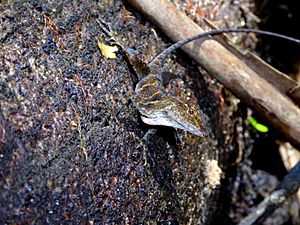Stuart's anole facts for kids
Quick facts for kids Stuart's anole |
|
|---|---|
 |
|
| Scientific classification | |
| Genus: |
Anolis
|
| Species: |
cobanensis
|
Anolis cobanensis, also known as Stuart's anole, is a type of lizard. It belongs to the family called Dactyloidae. These small lizards can be found in parts of Guatemala and Mexico. They are named after Laurence Cooper Stuart, the scientist who first described them in 1942.
Contents
What is an Anole?
Anoles are a large group of lizards. There are hundreds of different kinds! Most anoles live in warm, tropical places. They are known for their ability to change color. They also have a special throat flap called a dewlap.
Dewlap Display
The dewlap is a colorful piece of skin under an anole's chin. Males often have brighter dewlaps than females. They use this dewlap for many things. It helps them attract a mate. It also helps them warn other anoles to stay away from their territory.
Sticky Toes
Anoles have special pads on their toes. These pads are covered in tiny hairs. These hairs help them stick to many surfaces. They can climb up trees, walls, and even smooth leaves. This helps them move around their habitat easily.
Where Does Stuart's Anole Live?
Stuart's anole lives in specific areas. You can find them in the forests of Guatemala. They also live in parts of southern Mexico. These areas usually have warm temperatures and plenty of rain.
Forest Homes
These anoles prefer to live in forests. They spend most of their time in trees and bushes. They are often found on tree trunks or branches. This helps them hide from predators. It also gives them a good spot to look for food.
What Does Stuart's Anole Eat?
Like many lizards, Stuart's anole is an insectivore. This means it mostly eats insects. They are skilled hunters. They wait patiently for their prey.
Favorite Foods
Their diet includes a variety of small insects. They might eat crickets, spiders, or small beetles. They use their quick movements to catch their meals. Eating insects helps control insect populations in their environment.
How Does Stuart's Anole Look?
Stuart's anole is a small to medium-sized lizard. Its body is slender. It has a long tail. The colors can vary, but they often blend in with their forest home. This helps them stay hidden.
Color and Pattern
They usually have shades of brown or green. This helps them camouflage against tree bark and leaves. Some might have patterns or spots on their bodies. These patterns can also help them blend in.
Life Cycle and Reproduction
Anoles, including Stuart's anole, reproduce by laying eggs. The female anole will lay her eggs in a safe spot. This is usually in soft soil or under leaf litter.
Egg Laying
After mating, the female will find a good place for her eggs. She usually lays one or two eggs at a time. The eggs are small and soft. She buries them to keep them safe.
Hatching and Growth
The eggs will hatch after some time. Small anole babies, called hatchlings, emerge. They are tiny versions of the adults. They must find food and avoid predators on their own. They grow quickly until they reach their adult size.
Conservation Status
The conservation status of Stuart's anole is not widely known. Many anole species face challenges. These challenges include habitat loss. When forests are cut down, anoles lose their homes.
Protecting Habitats
Protecting their forest habitats is important. This helps ensure that Stuart's anole and other animals can continue to thrive. Scientists continue to study these lizards. This helps us learn more about them and how to protect them.
See also

